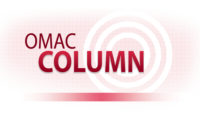OMAC Column
HMI Standardization: A Path Forward

Innovations in digital technology have pushed packaging equipment to new levels of productivity and efficiency — yet have also created more complexity and a dizzying array of Human Machine Interfaces (HMIs). For most end-users, it’s common to have packaging lines with multiple HMIs, each with different levels of complexity and interactions. This lack of standardization can even exist across machines of a single type or brand, particularly if those machines are purchased at different times.
Improvements to HMI consistency are necessary in order to continue advancing productivity and OEE. The primary challenge is finding the way to achieve operational benefits without restricting the ability of a machine and controls builder to innovate and differentiate its products. Building on existing standards and best practices offers a solid, achievable path forward.
Many machine builders, controls providers and end-users have successfully integrated PackML’s machine states into their systems to increase efficiency and interoperability. It is reasonable to argue that overall efficiency and usability has been limited by different interpretations of how to present common machine states and error messaging. Accordingly, it is expected that additional efficiency, usability and safety benefits could be achieved by adopting consistent guidelines for presenting and representing already defined machine states.
To help clear the way, OMAC’s Packaging Workgroup has begun developing a PackML HMI Implementation Guide, which will focus on establishing common navigation structures in graphical interfaces and increasing consistency in the presentation of machine states. The workgroup — which includes end users, OEMs and technology providers — is expected to facilitate appropriate boundaries and achievable guidelines that improve usability and effectively reduce operator training needs and line integration complexity, while preserving the unique features that differentiate one OEM from another.
Similar “standards” exist in the high-level navigation systems found in competing computer operating systems. While minor aesthetic differences may exist between vendors, operating systems present a relatively consistent progression of menus, beginning most notably with the ubiquitous “File” menu. Conventions evolve over time and come to be expected. Interfaces that conflict with expected conventions typically reduce operator satisfaction. One goal of the working group is to begin formalizing usability conventions within the context of packaging machine HMIs. Packaging interfaces that conflict with conventions that operators expect will likely reduce operator efficiency and could even introduce safety risks.
In addition to the more abstract graphical interface concepts, guidance will include a machine stack light standard that aligns machine light trees with the PackML state model. Currently, the meaning of red, green, yellow and blue lights found in machine light trees can vary from machine to machine. By consistently aligning the lights with machine states, production personnel will be able to quickly assess each machine in the line during operation.
PackML HMI Navigation Survey
As part of its efforts, OMAC will be presenting a set of HMI designs at PACK EXPO International to gather both qualitative and quantitative input from representative users. Survey participants will be asked to perform a series of tasks that will help characterize their preferences. The goal is not necessarily to determine which design is the best, but to gather data and establish a path for the creation of beneficial standards and best practices.
The 10-minute evaluation will help the working group appropriately identify interface characteristics that have the greatest influence on operator effectiveness. Accordingly, findings will illustrate the benefits and limitations of competing HMI designs, which will be synthesized as guidance for the packaging community.
To participate in the survey, visit OMAC at booth N-6002 during PACK EXPO International, October 14-17 in Chicago.
Looking for a reprint of this article?
From high-res PDFs to custom plaques, order your copy today!







